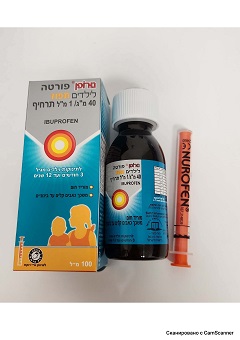Quest for the right Drug

נורופן פורטה לילדים תפוז 40 מ"ג/1 מ"ל תרחיף NUROFEN FORTE FOR CHILDREN ORANGE 40MG/1ML SUSPENSION (IBUPROFEN)
תרופה במרשם
תרופה בסל
נרקוטיקה
ציטוטוקסיקה
צורת מתן:
פומי : PER OS
צורת מינון:
תרחיף : SUSPENSION
עלון לרופא
מינוניםPosology התוויות
Indications תופעות לוואי
Adverse reactions התוויות נגד
Contraindications אינטראקציות
Interactions מינון יתר
Overdose הריון/הנקה
Pregnancy & Lactation אוכלוסיות מיוחדות
Special populations תכונות פרמקולוגיות
Pharmacological properties מידע רוקחי
Pharmaceutical particulars אזהרת שימוש
Special Warning עלון לרופא
Physicians Leaflet
Pharmacological properties : תכונות פרמקולוגיות
Pharmacodynamic Properties
5.1 Pharmacodynamic properties Pharmacotherapeutic group: anti-inflammatory and antirheumatic products, non steroids; propionic acid derivatives. ATC code: M01AE01 Ibuprofen is a non-steroidal anti-inflammatory drug (NSAID) that has demonstrated its efficacy in the common animal experimental inflammation models by inhibition of prostaglandin synthesis. In humans, ibuprofen reduces inflammatory pain, swellings and fever. Furthermore, ibuprofen reversibly inhibits platelet aggregation. The clinical efficiency of ibuprofen has been demonstrated in the symptomatic treatment of mild to moderate pain such as pain through toothache, headache, and in the symptomatic treatment of fever. The analgesic dose for children is 7 to 10 mg/kg per dose with a maximum of 30 mg/kg/day. Nurofen for Children 200 mg/5 ml Orange contains Ibuprofen which showed in an open-label study an onset of antipyretic action after 15 minutes and decreases fever in children for up to 8 hours. Experimental data suggest that ibuprofen may competitively inhibit the effect of low dose acetylsalicylic acid on platelet aggregation when they are dosed concomitantly. Some pharmacodynamic studies show that when single doses of ibuprofen 400 mg were taken within 8 h before or within 30 min after immediate release acetylsalicylic acid dosing (81 mg), a decreased effect of acetylsalicylic acid on the formation of thromboxane or platelet aggregation occurred. Although there are uncertainties regarding extrapolation of these data to the clinical situation, the possibility that regular, long-term use of ibuprofen may reduce the cardioprotective effect of low- dose acetylsalicylic acid cannot be excluded. No clinically relevant effect is considered to be likely for occasional ibuprofen use (see section 4.5).
Pharmacokinetic Properties
5.2 Pharmacokinetic properties No special studies on pharmacokinetics have been carried out in children. Literature data confirm that the absorption, metabolism and elimination of ibuprofen in children proceeds in the same way as in adults. After oral administration ibuprofen is partly absorbed in the stomach and afterwards completely in the small intestine. After hepatic metabolism (hydroxylation, carboxylation, conjugation) the pharmacologically inactive metabolites are eliminated completely, mainly renally (90 %), as well as via the biliary route. The elimination half life for healthy persons as well as for patients suffering from hepatic or renal diseases is 1.8 to 3.5 hours. Plasma protein binding is about 99 %. Renal impairment Since ibuprofen and its metabolites are primarily eliminated by the kidneys, patients with varying degrees of renal impairment may display altered pharmacokinetics of the active substance. For patients with renal impairment decreased protein binding, increased plasma levels for total ibuprofen and unbound (S)- ibuprofen, higher AUC values for (S)- ibuprofen and increased enantiomeric AUC (S/R) ratios as compared with healthy controls have been reported. In end-stage renal disease patients receiving dialysis the mean free fraction of ibuprofen was about 3% compared with about 1% in healthy volunteers. Severe impairment of renal function may result in accumulation of ibuprofen metabolites. The significance of this effect is unknown. The metabolites can be removed by haemodialysis (see also section 4.3) Hepatic impairment Alcoholic liver disease with mild to moderate hepatic impairment did not result in substantially altered pharmacokinetic parameters. Hepatic disease can alter the disposition kinetics of ibuprofen. In cirrhotic patients with moderate hepatic impairment (Child Pugh’s score 6-10) an average 2-fold prolongation of the half-life was observed and the enantiomeric AUC ratio (S/R) was significantly lower compared to healthy controls suggesting an impairment of metabolic inversion of (R)- ibuprofen to the active (S)- enantiomer (see also section 4.3)

שימוש לפי פנקס קופ''ח כללית 1994
לא צוין
תאריך הכללה מקורי בסל
לא צוין
הגבלות
לא צוין
מידע נוסף
לתרופה במאגר משרד הבריאות
נורופן פורטה לילדים תפוז 40 מ"ג/1 מ"ל תרחיף